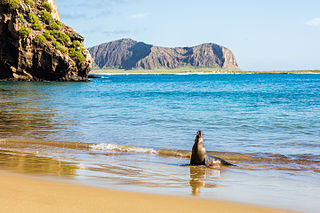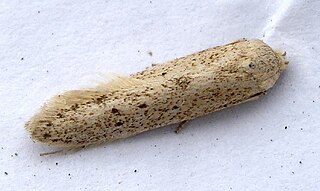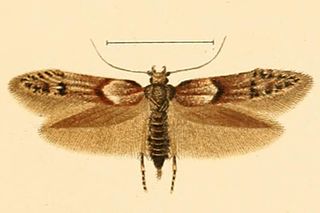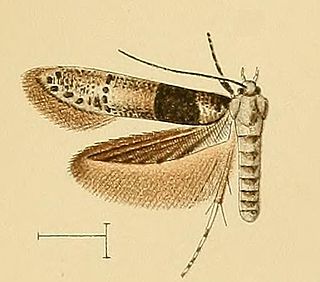
The Galápagos Islands are an archipelago of volcanic islands in the Eastern Pacific, located around the Equator 900 km (560 mi) west of South America. They form the Galápagos Province of the Republic of Ecuador, with a population of slightly over 33,000 (2020). The province is divided into the cantons of San Cristóbal, Santa Cruz, and Isabela, the three most populated islands in the chain. The Galápagos are famous for their large number of endemic species, which were studied by Charles Darwin in the 1830s and inspired his theory of evolution by means of natural selection. All of these islands are protected as part of Ecuador's Galápagos National Park and Marine Reserve.

The Pinta Island tortoise, also known as the Pinta giant tortoise, Abingdon Island tortoise, or Abingdon Island giant tortoise, is a recently extinct subspecies of Galápagos tortoise native to Ecuador's Pinta Island.

The Blastobasidae are a family of moths in the superfamily Gelechioidea. Its species can be found almost anywhere in the world, though in some places they are not native but introduced by humans. In some arrangements, these moths are included in the case-bearer family (Coleophoridae) as subfamily Blastobasinae. The Symmocidae are sometimes included in the Blastobasidae as subfamily or tribe.
Auximobasis is a genus of the gelechioid moth family Blastobasidae. It is sometimes included in Blastobasis.

Blastobasis is the type genus of the gelechioid moth family Blastobasidae; in some arrangements these are placed in the case-bearer family (Coleophoridae) as a subfamily. Within the Blastobasidae, the subfamily Blastobasinae has been established to distinguish the Blastobasis lineage from the group around Holcocera, but the delimitation is not yet well-resolved.

Blastobasis adustella is a species of moth of the family Blastobasidae. It is endemic to Australian region, but was introduced in western Europe and is now reported from The Netherlands, Great Britain, Ireland, Madeira and the Azores
Blastobasis vittata is a moth of the family Blastobasidae. It was thought to be endemic to Madeira but is now known to inhabit the Netherlands, France, the Channel Islands, England and Northern Ireland.

Sabatinca doroxena is a species of moth belonging to the family Micropterigidae. It is endemic to the North Island of New Zealand. This small moth has a colourful forewing pattern with stripes and dots evident. It has been hypothesised that the forewing pattern is intended to resemble a jumping spider in order to allow the adult moth to escape predation. Adults of this species are on the wing from the beginning of September until mid January. It prefers damp but sunny habitat in deep forest, at the forest edge or in open shrubland. Larvae feed on foliose liverwort species including on Heteroscyphus normalis. Adults of this species have been located at the blossoms of flowering Cordyline and Ranunculus species.
Scopula normalis is a moth of the family Geometridae. It is found in Madagascar.
Blastobasis egens is a moth in the family Blastobasidae. It is found in South Africa and the Democratic Republic of the Congo.

Blastobasis exclusa is a moth in the family Blastobasidae. It is found on the Canary Islands.

Blastobasis helleri is a moth in the family Blastobasidae. It is found on the Canary Islands.
Blastobasis insularis is a moth in the family Blastobasidae. It is found on the Canary Islands and Madeira.
Blastobasis magna is a moth in the family Blastobasidae. It is found on the Channel Islands, in Italy, Portugal, Spain and on Sardinia and Sicily.

Blastobasis marmorosella is a moth in the family Blastobasidae. It is found on the Canary Islands, Madeira and in Portugal and Spain. This species has been accidentally introduced to Australia and New Zealand.
Blastobasis maroccanella is a moth in the family Blastobasidae. It is found on the Azores, Madeira and in Portugal, Spain and Morocco. It was recently reported from California in the United States.

Blastobasis rubiginosella is a moth in the family Blastobasidae. It is found on the Canary Islands.

Blastobasis velutina is a moth in the family Blastobasidae. It is found on the Canary Islands.
Blastobasis retectella is a moth in the family Blastobasidae. It is found in the United States, including Texas, Florida and Maine.
Blastobasis lososi is a moth in the family Blastobasidae that is endemic to Fiji.









